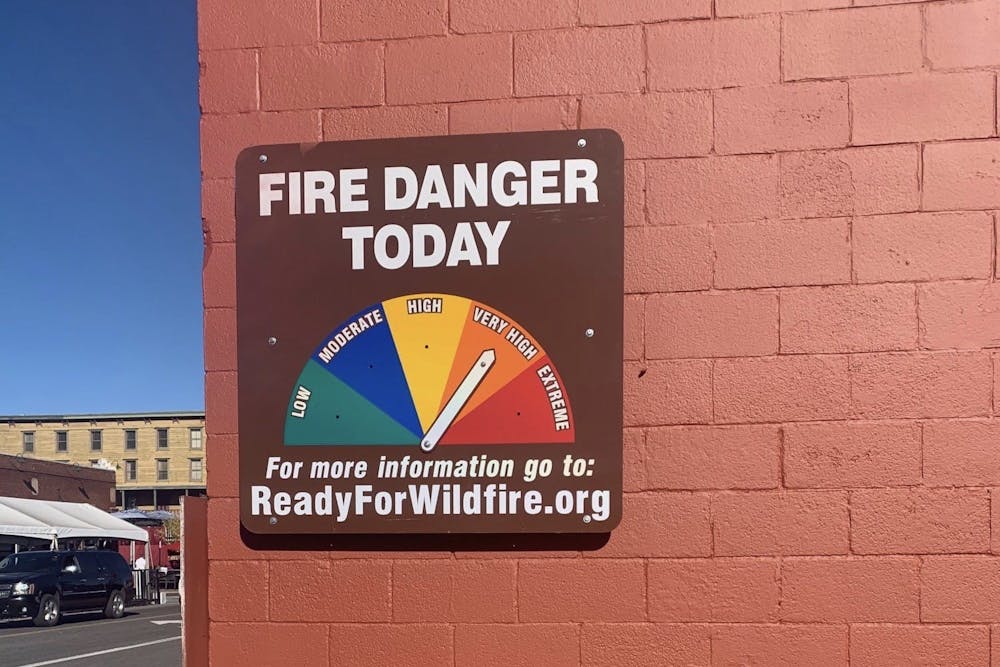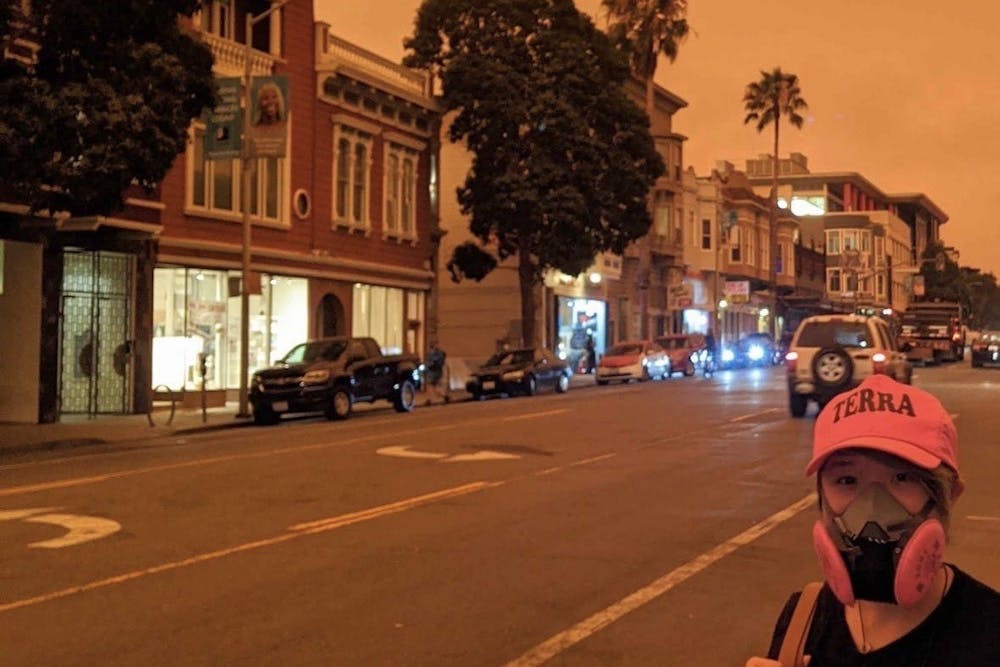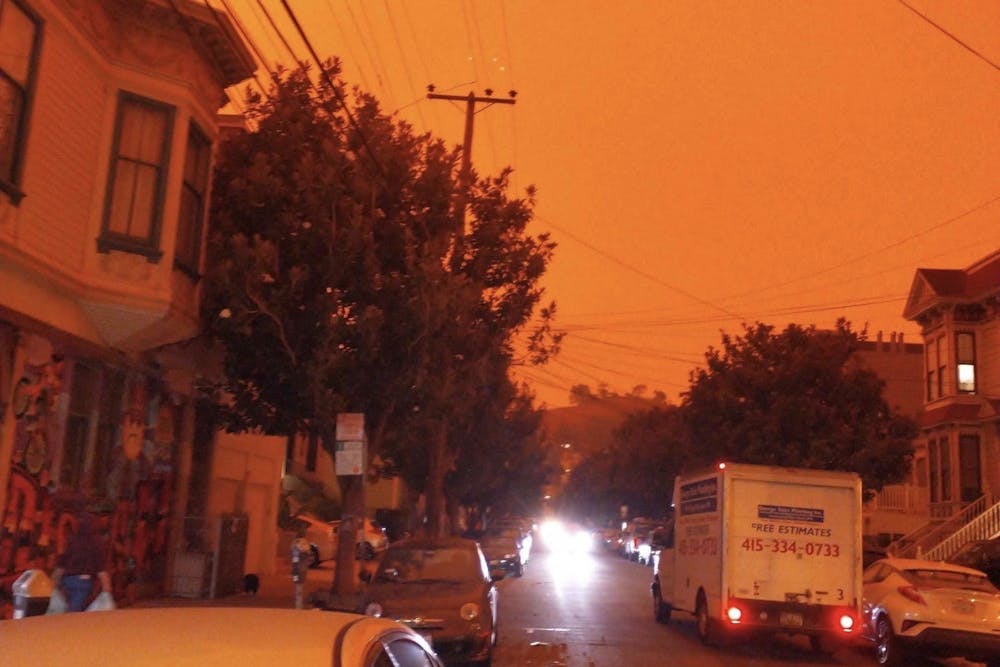When Mona Wang GS looked out her window in San Francisco on Sept. 9, she “wondered if the apocalypse was coming.”
Social media and national news reacted similarly. Photos of the day’s suffocating orange skies circulated on the Internet, prompting widespread alarm. But while the online fervor soon died down, Californian residents suffered a record-breaking wildfire season that, to date, has set over 4.7 million acres across California and Oregon ablaze.
The Daily Princetonian spoke with several Princeton students among those residents about life amid the wildfires and what comes next.
Charlie Cowen-Breen ’22, originally from Boston, moved to California for the fall to live with friends — a decision that proved more consequential than he ever imagined.
Starting his semester in San Luis Obispo, Cowen-Breen moved north to Lake Tahoe in late September. He reflected on the conditions upon arriving.
“There was a very scary sounding critical fire warning in Lake Tahoe the day that we arrived,” he recalled. Cowen-Breen then read the precautions that California’s state government released that day:
“‘Now is the time to ensure your vehicle has a full tank of fuel and is parked facing out, your devices are charged, your emergency go kit is currently within reach, and your family and pets are prepared, practiced, and ready to evacuate.’”
He shared a photograph of an air quality marker located in town, noting that it reminded him of “a doomsday clock.” The occasional Boston blizzard had hardly prepared him for such a tinderbox.


Lake Tahoe Air Quality Marker.
Courtesy of Charlie Cowen-Breen ’22
Wang, by contrast, has lived in the Bay Area for six years; she knows the drill when it comes to the wildfire season. She’s fully equipped with a pink gas mask, a window insulator, and an air filter. The last two purchases came after a smoke alarm went off in the middle of the night — poisonous smoke from the fires had been seeping into her home, despite Wang’s windows being shut.
But this fall presented new, more dangerous circumstances.
Fires in other areas spelled trouble for her friends, and she welcomed an influx of evacuees into her house. Already quarantined for COVID-19, she was forced to remain house-bound for a week due to the air’s high smoke content. With the looming possibility of evacuation, not to mention days when the sun didn’t rise, Wang said, “it was hard to get work done.”

Bridgette Schafer ’24, currently on a gap year, also calls the San Francisco Bay Area home — one that felt very alien this year.
“They told us to be ready to evacuate two separate times because there were dry lightning warnings,” Schafer recalled. “We had our bags packed. Everyone was terrified.”
More mentally taxing than those warnings was the perpetual sense of alarm; Schafer recalled the days of extreme heat and high winds, in which her town had to be on high alert. She didn’t remember these happening with such frequency in past years.
“On those days, if a spark catches, our entire town could go up in flames.”
Schafer related an experience from early September: “I was at the beach, and as we were there we saw a fire start on a hill across from us. It blew across the whole skyline and covered the entire horizon.”
The last fire was only a few weeks ago, right across the street from her old high school. With fires in such close proximity, Schafer’s family decided to take extra precautions this season. They bought a pump hose to connect to their pool, in case they needed to spray down their house before evacuating.
“I got super paranoid one day because leading up to our backyard is all this dry hillside,” she recalled. “So I borrowed a rake from a friend and spent the day moving all the dry grass away from our house — I just figured, if this catches, we’re done for.”
On a day-to-day basis, Schafer has experienced heightened anxiety — not to mention headaches, fatigue, and other side effects from being forced to stay inside. She usually relies on runs, hikes and other outdoor activities as part of her daily routine. Since the wildfires season started, she’s fallen back on Nike app indoor workouts and online yoga.
The forced retreat indoors reminded Wang of the spring’s quarantine.
“It’s hard to separate the fires from coronavirus and the general political state of the world,” she said.
The fires’ intersection with COVID-19 also weighed on Schafer. Both Schafer and Wang found that their masks served a dual purpose.
“Masks have been a helpful normalization,” Schafer said. “In past years, even with bad fires, we’d have to go to school; some kids would wear masks, which was abnormal to see. Now, thank goodness, we all have to wear our masks outside, because it helps me breathe.”
Wang’s gas mask, purchased two years ago, resembles a prop out of a cyberpunk film. To her, the object has come to represent the upheaval of this year. She’s used it on three separate occasions: during the mask shortage in March; against pepper spray during Black Lives Matter protests in June; and in September, when the wildfire smoke was so bad that the California sky turned orange for two days.

Mona Wang GS with her gas mask.
Courtesy of Mona Wang GS
October brought cooler weather, and with it a lowered wildfire risk. After months of contaminated air and falling ash so thick it obscured her car windows, Schafer celebrated her “first clear day.”
“Everyone went outside to see the blue sky, just sucking in the air,” Schafer remembered. “That kind of relief about clean air — I hadn’t felt that ever before.”
As the wildfire season finally cools down, attention is turning to the Nov. 3 election; the students find themselves armed with only their ballots as the climate disaster escalates.
“As a voter this year, which I’ve never been before, it’s interesting to see how people’s campaigns are built around this tragedy,” Schafer said. “Each person running for city council has said that fires are one of their top three priorities ... and for people’s campaigns, being endorsed by the firefighters is a huge selling point.”
She worries that campaigns are leveraging this fall’s fear and stress to gain voter support. Nonetheless, she found the “lack of national government response” even more troubling — seeing local government officials eager to do something about the fires, she said, is better than nothing.
And with climate change as such a central issue in the presidential election, Schafer hopes that the severity of this fire season will send a message.
“It’s definitely a wake up call for some people,” Schafer said. “The classic examples of climate change — ice caps melting, sea levels rising — those are hard to see in your day-to-day life. But when the sky is covered in smoke and you’re looking around your room trying to decide what to take with you if you evacuate, it gets way too real.”
Wang shared a similar sentiment — she placed an onus on national, rather than individual, action as the way to move forward.
“I think there needs to be systemic change for anything to happen. The fires have led me to feel a little bit hopeless, because not using a plastic straw isn’t going to save your friend’s house that burnt down."








